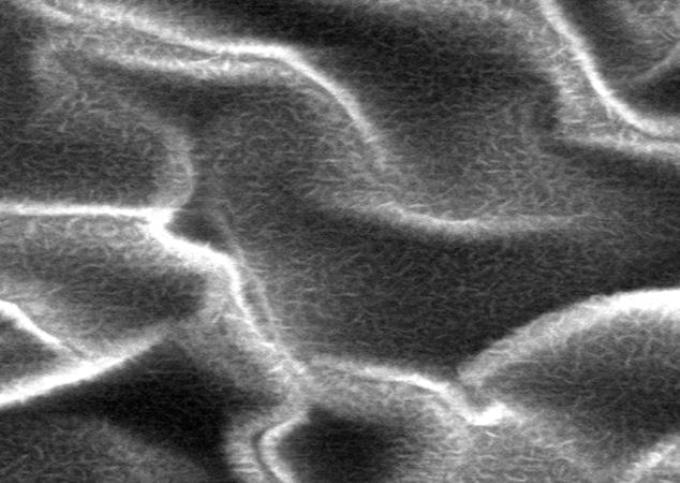Dec 20 2018
 This is a scanning electron microscope image of atomically-thin MoS2 with hierarchical, dual-scale structures. (Credit - SungWoo Nam, University of Illinois)
This is a scanning electron microscope image of atomically-thin MoS2 with hierarchical, dual-scale structures. (Credit - SungWoo Nam, University of Illinois)
Widely used as a solid lubricant, molybdenum disulfide (MoS2) has now been discovered to have a two-dimensional (2D) form that is similar to graphene. When MoS2 is thinned down to below a nanometer in thickness, it exhibits characteristics with great potential as a functional material for surface coatings and electronic devices.
A team of researchers from the University of Illinois at Urbana-Champaign have developed a new technique to dynamically adjust the micro-and nano-scale roughness of atomically thin MoS2, and as a result the appropriate degree of hydrophobicity for a range of promising MoS2-based applications.
The knowledge of how new materials interact with water is a fundamental. Whereas the wettability of its more famous cousin, graphene, has been substantially investigated, that of atomically thin MoS2 - in particular atomically thin MoS2 with micro- and nano-scale roughness - has remained relatively unexplored despite its strong potential for fundamental research and device applications. Notably, systematic study of how hierarchical microscale and nanoscale roughness of MoS2 influence its wettability has been lacking in the scientific community.
SungWoo Nam, Assistant Professor, University of Illinois
“This work will provide a new approach to dynamically tune the micro- and nano-scale roughness of atomically thin MoS2 and consequently the appropriate degree of hydrophobicity for various potential MoS2-based applications,” stated Jonghyun Choi, a mechanical engineering graduate student and first author of the article, “Hierarchical, Dual-Scale Structures of Atomically Thin MoS2 for Tunable Wetting,” appearing in the Nano Letters journal. “These include waterproof electronic devices with superhydrophobicity with water contact angle greater than 150 degrees. It may also be useful for medical applications with reduced hydrophobicity (WCA less than 100 degrees) for effective contact with biological substances."
The team explains that their study expands the toolkit to allow tunable wettability of 2D materials, several of which are only now being discovered.
When deformed and patterned to produce micro- and nano-scale structures, MoS2 shows promise as a functional material for hydrogen evolution catalysis systems, electrodes for alkali metal-ion batteries, and field-emission arrays. The results should also contribute to future MoS2-based applications, such as tunable wettability coatings for desalination and hydrogen evolution.
SungWoo Nam, Assistant Professor, University of Illinois
Besides Nam and Choi, co-authors of the paper include graduate students Michael Cai Wang and Ali Ashraf (Illinois), Jihun Mun and Sang-Woo Kang (Korea Research Institute of Standards and Science, Korea). Experiments were conducted partly in the Frederick Seitz Materials Research Laboratory, the Micro + Nano Technology Laboratory, and the Beckman Institute Imaging Technology Group at Illinois.